As you step into your garden, you’re greeted by the vibrant green of your tomato plants, standing tall with the promise of summer’s bounty. Growing tomatoes is not just about planting; it’s an emotional journey—one that connects you with nature and brings joy to your table. But what if I told you that enhancing this journey is as simple as knowing what to plant with tomatoes? Companion planting opens a world of possibilities, where the right plants not only support your tomatoes but also create a harmony in your garden that is both fulfilling and fruitful. Let’s dive into the essentials of tomato companion planting, exploring the diverse allies that can turn your gardening experience into a thriving adventure.
Key Takeaways
- Companion planting enhances the growth and health of tomato plants.
- Choosing the right companions can help repel pests naturally.
- Specific herbs and flowers work symbiotically with tomatoes.
- Strategically planting companions can boost yield and flavor.
- Understanding plant relationships is key to a successful garden.
Understanding Companion Planting
Companion planting is a wonderful method to enhance your gardening experience, especially when growing tomatoes. By carefully selecting which plants to pair together, you tap into a natural ecosystem that promotes growth, health, and productivity. This technique not only maximizes space in your garden but also creates a harmonious environment that benefits both your tomatoes and their companions. Understanding the benefits of companion planting can help you foster a thriving tomato garden.
Benefits of Companion Planting
The benefits of companion planting are numerous and can greatly impact your garden’s overall success. Some key advantages include:
- Nutrient Enhancement: Certain plants can improve soil fertility, making nutrients more available for your tomatoes.
- Pest Control: Companion plants can repel harmful insects, protecting your tomatoes from pests.
- Increased Pollination: Flowers and herbs can attract beneficial pollinators, boosting tomato productivity.
- Efficient Space Utilization: Growing compatible plants together allows you to maximize your garden’s potential.
How It Works with Tomatoes
When it comes to tomato garden companions, plants like basil and marigolds are particularly beneficial. Basil enhances the flavor of tomatoes while also repelling aphids and whiteflies. Marigolds add vibrant color and act as a natural pest deterrent. Together, these plants create a biome that nurtures tomatoes, leading to healthier plants and higher yields.
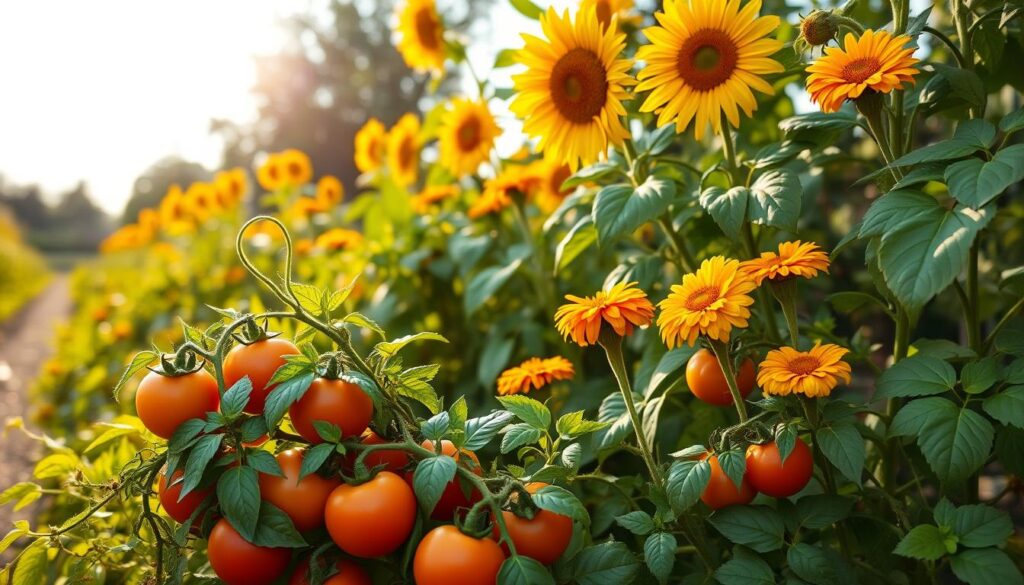
In addition to these advantages, companion planting helps create a natural balance within your garden. By understanding how different plants interact, you can build a supportive environment that promotes vigorous growth and resilience. Any gardener looking to optimize their tomato garden should consider the myriad benefits of this planting strategy.
Ideal Companions for Tomatoes
When it comes to cultivating a thriving garden, choosing the right plants to grow alongside your tomatoes can significantly enhance their growth and flavor. The best plants to grow with tomatoes not only contribute to the overall ecosystem of your garden but also provide various benefits such as pest deterrence and improved taste. Here’s a closer look at some of the top tomato plant companions.
Basil: A Flavorful Ally
Basil is often regarded as one of the best plants to grow with tomatoes. This aromatic herb does more than just complement the flavor of your dishes; it also helps to ward off pests like thrips and hornworms thanks to its strong scent. Combining basil with your tomatoes can lead to a healthier crop while enhancing your culinary creations.
Marigolds: Pest Deterrent Power
Marigolds hold a historic reputation for being effective at keeping harmful insects at bay, making them excellent tomato plant companions. By planting marigolds nearby, you can deter unwanted pests such as whiteflies, which can jeopardize the health of your tomato plants. Their vibrant blooms not only elevate the beauty of your garden but also play a crucial role in pest management.
Garlic: Bulbs that Boost Growth
Garlic is another powerful ally in the garden. Known for its robust aroma, garlic acts as a natural deterrent against spider mites and various diseases. Growing garlic alongside your tomatoes can promote a better overall growing environment, ensuring that your tomato plants remain healthy and productive throughout the season.
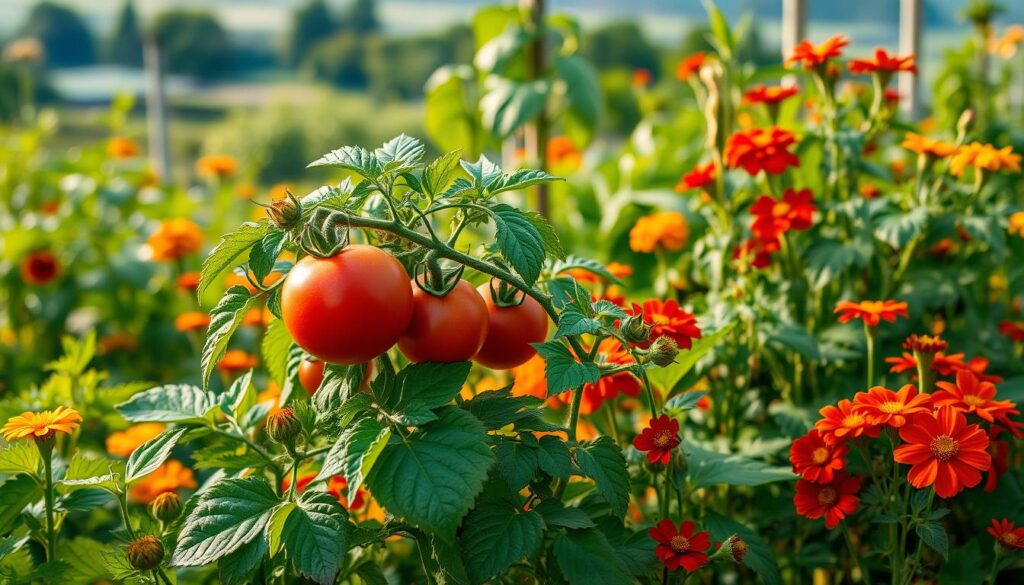
Herb Companions for Tomato Plants
Incorporating the right herbs into your garden can greatly benefit your tomato plants. Some herbs are not only flavorful additions to your dishes but also serve as effective companion plants for tomatoes. Oregano and thyme, in particular, stand out for their unique properties and advantages.
Oregano: Flavor and Health Benefits
Oregano thrives alongside tomatoes, offering rich culinary flavor while attracting beneficial insects. This herb is known for its robust growth, which helps to enhance the overall health of your garden. You will notice that the presence of oregano facilitates nutrient sharing and can even improve pollination, making it one of the best herbs for tomato plants.
Thyme: Aromatic and Resilient
This hardy herb acts as a low-growing mulch, providing moisture retention in your garden. Thyme’s aromatic nature not only enhances your dishes but also serves as a deterrent to pests like armyworms. Including thyme in your garden enriches the environment around your tomato plants, actively supporting their growth as a valuable companion plant.
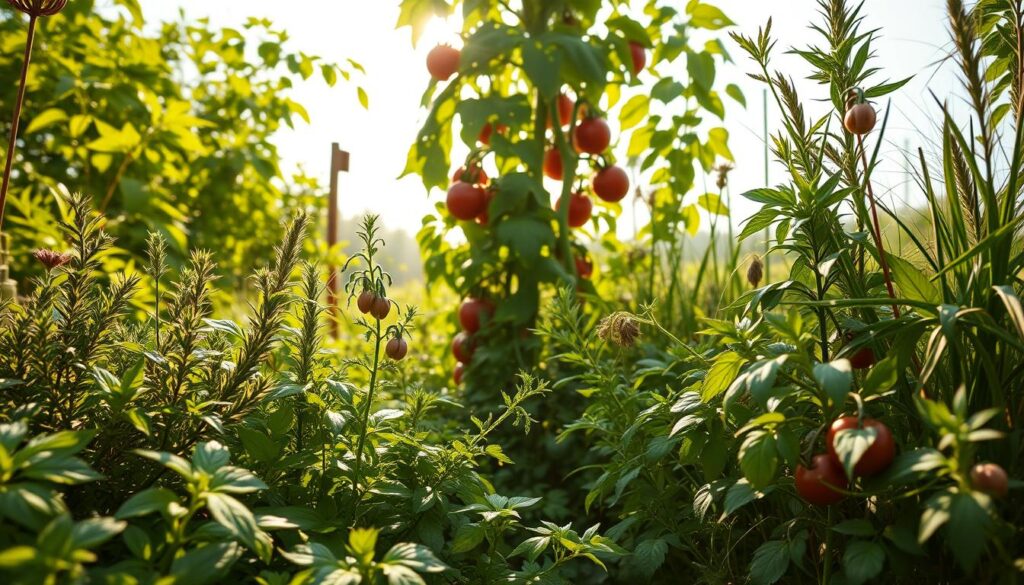
Vegetables to Pair with Tomatoes
When planting tomatoes, consider the vegetables to plant with tomatoes that can enhance both growth and flavor. Some vegetables complement tomatoes well, each bringing unique benefits to your garden.
Peppers: A Spicy Relationship
Peppers have similar sunlight and watering requirements as tomatoes, making them a popular choice among gardeners. Their vibrant colors and flavors can elevate any dish. Caution is essential since both belong to the nightshade family, which can increase the risk of blight. Planting them together can create a beautiful and productive garden layout.
Carrots: Grounded Companions
Carrots serve as excellent companions in your garden. Their deep roots aerate the soil, promoting healthy tomato growth. Additionally, tomatoes offer shade, which can be beneficial for growing carrots. Both vegetables to plant with tomatoes create a symbiotic relationship that fosters a thriving garden environment.

Flowers That Complement Tomatoes
In your quest for a thriving tomato garden, choosing the right flowers can prove beneficial. Flowers that thrive with tomatoes enhance growth, attract beneficial insects, and deter harmful pests. Two standout choices for tomato companions are borage and nasturtiums.
Borage: Attractive and Beneficial
Borage not only brings beauty to your garden but also serves multiple purposes. This charming flower attracts bees, which are essential for pollination. Additionally, borage helps in deterring pests like the tomato hornworm. Its roots also improve soil health by adding nutrients, making it a valuable companion to your tomato plants.
Nasturtiums: Edible and Colorful
Nasturtiums add a burst of color and can serve as a delightful edible addition to your meals. These flowers act as trap crops for aphids, drawing them away from your tomatoes. By attracting beneficial pollinators, nasturtiums further enhance the diversity within your tomato companions. Their vibrant flowers not only elevate the aesthetic of your garden but also offer unique flavors for salads and dishes.
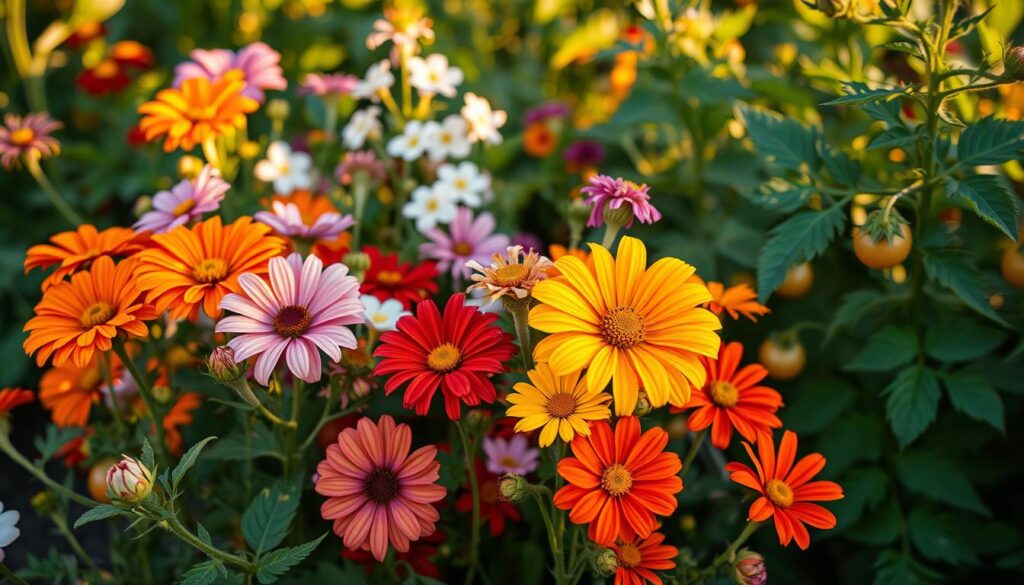
Avoid Planting: Tomato Foes
When planning your garden, it’s essential to recognize the plants that aren’t good for tomatoes. Some neighboring plants can inhibit the growth of your tomatoes or attract unwanted pests. Let’s explore which plants to avoid and understand their potential negative effects.
What Not to Plant with Tomatoes
- Corn
- Brassicas (cabbage, broccoli, kale)
- Other nightshades (eggplant, peppers)
Effects of Poor Companions
Choosing the wrong companions can lead to poor growth and yield. For instance, corn often attracts pests that are harmful to tomatoes, creating unhealthy competition for resources in your garden. Brassicas may release compounds that hinder tomato growth, leading to stunted plants. Understanding these relationships will help you avoid the plants that aren’t good for tomatoes and foster a more productive garden.
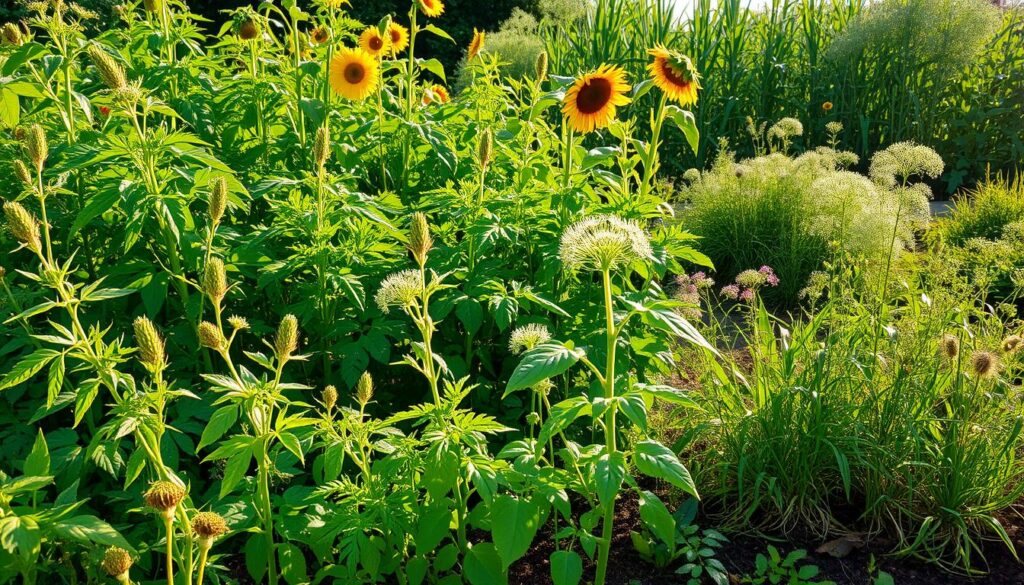
Planting Tips for Tomato Companions
Implementing effective companion planting strategies can significantly enhance the growth and health of your tomato plants. By considering optimal spacing and timing, you can create a thriving garden that maximizes the benefits of your plants.
Spacing and Arrangement Strategies
Proper spacing between companion plants is essential to promote healthy growth and air circulation. Taller plants should be positioned where they will not overshadow shorter companions. This thoughtful arrangement ensures each plant receives adequate sunlight and resources. Key spacing tips include:
- Keep at least 18 to 24 inches between tomato plants and their companions to avoid overcrowding.
- Group plants with similar water and sunlight requirements together for optimal growth.
- Consider the mature size of each plant when arranging them in your garden plot.
Timing Your Planting for Success
Timing is crucial for the effective integration of your tips for tomato companions. It is important to establish companion plants either before or concurrently with the tomatoes. This approach helps with pest control and allows better nutrient sharing. Follow these timing guidelines:
- Plant fast-growing companions like basil and marigolds at the same time as your tomatoes.
- Start slower-growing plants, such as garlic, a few weeks prior to planting tomatoes for the best impact.
- Monitor local frost dates to avoid planting too early or too late in the season.
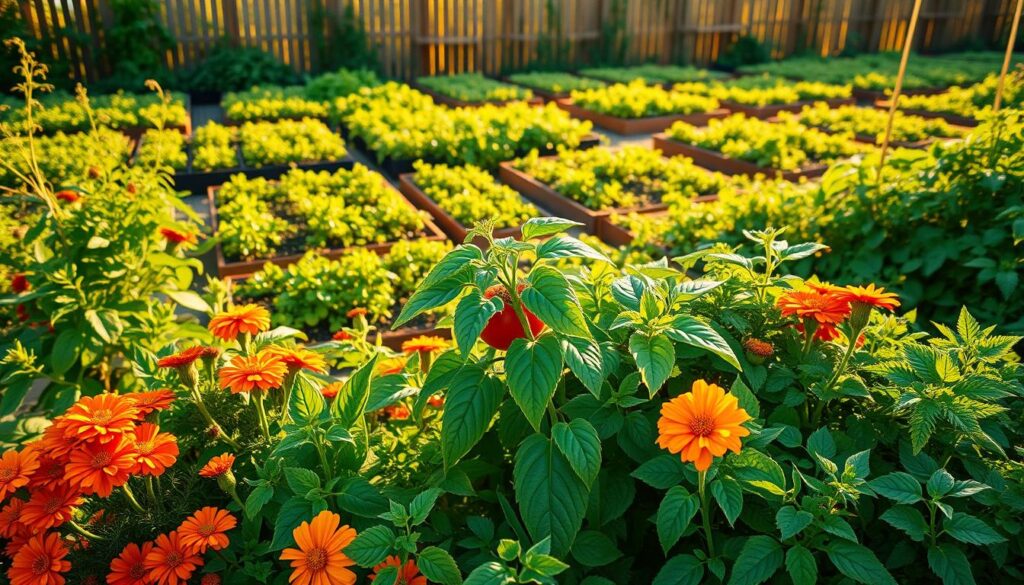
Seasoned Gardeners Share Insights
Experienced gardeners have invaluable wisdom when it comes to companion planting and nurturing tomato plants. Their personal experiences often highlight unique approaches that enhance not only the growth of tomatoes but also the overall health of your garden.
Personal Experiences with Companion Plants
Many seasoned gardeners emphasize the effectiveness of diverse planting. For instance, strategically selecting companion plants can create a balanced ecosystem that discourages pests naturally. Gardeners often share stories about how certain combinations produced vibrant yields, transforming their gardening techniques. By experimenting with plant pairings like tomatoes and basil, they noticed enhanced flavors and sizes.
Tips from the Experts
To elevate your tomato gardening tips, consider adopting seasoned gardener strategies. One widely recommended practice is rotating crop families yearly to improve soil nutrient levels and reduce disease risks. Keeping a garden journal can be a treasure trove of insights, as it allows you to track results, document challenges, and celebrate successes. This reflective practice informs future planting decisions and fosters a sense of community among fellow gardeners.
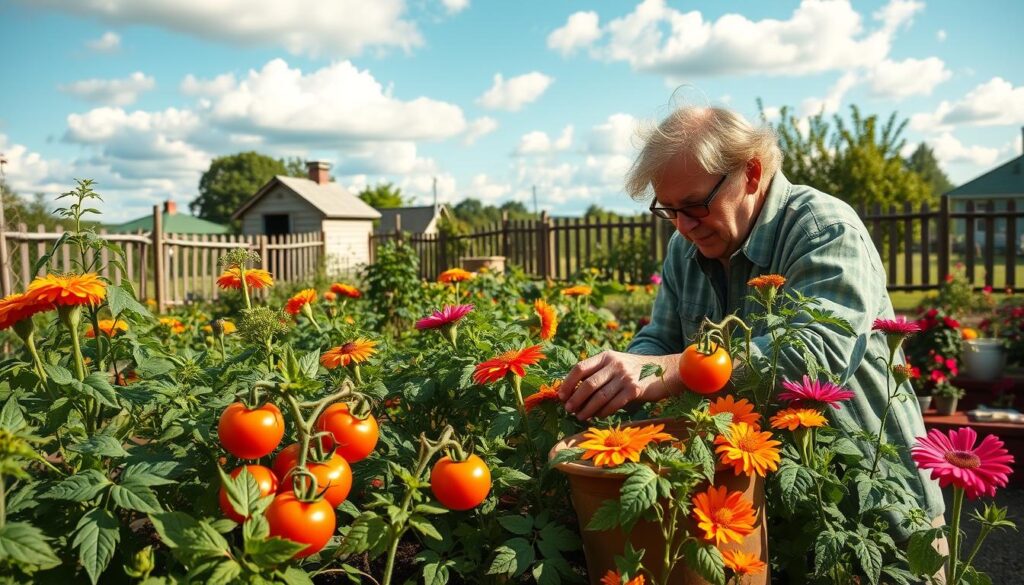
| Companion Plant | Benefits | Personal Experience |
|---|---|---|
| Basil | Enhances tomato flavor and repels pests | Noticed stronger tomato growth and less aphid presence |
| Marigolds | Pest control and added color | Decreased nematode issues and improved aesthetics |
| Garlic | Boosts growth and disease resistance | Significantly reduced blight, healthier plants overall |
Common Mistakes in Companion Planting
Companion planting can yield impressive results, but several common companion planting mistakes can undermine your efforts. Understanding these pitfalls will help you create a flourishing garden that effectively supports your tomato plants.
Overcrowding Your Tomato Plants
One of the most prevalent common companion planting mistakes is overcrowding. When planting tomatoes alongside companions, maintaining adequate spacing is essential. Overcrowding can lead to poor air circulation, making your plants more susceptible to diseases and pests. Allowing each plant room to grow not only ensures healthy development but enhances the overall vigor of your garden.
Ignoring Plant Nutritional Needs
Another significant error in companion planting is neglecting the specific nutritional requirements of different plants. Each variety of tomato and its companions may require distinct soil nutrients to thrive. Failing to address these needs can stunt growth and lead to underwhelming harvests. Regularly assess the soil quality and consider using organic fertilizers tailored to the needs of your companion plants, paving the way for a more successful gardening experience.
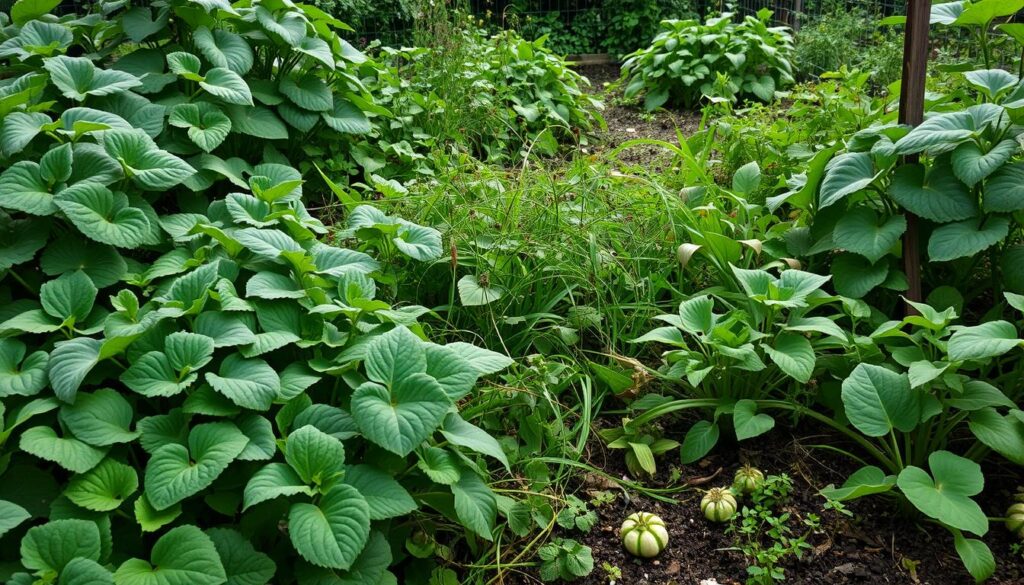
Fertilization and Companion Relationships
Understanding how plants interact with one another goes beyond mere companionship; it involves nutrient sharing that can significantly enhance growth and health. When you strategically choose companion plants, like tomatoes and legumes, you create a balanced environment that thrives on shared nutrients. Legumes fix nitrogen in the soil, which is essential for your tomato plants that require high nitrogen levels for optimal growth.
Nutrient Sharing Between Plants
Plants communicate their needs and can benefit from one another, especially concerning nutrient availability. For example, companion planting can lead to improved soil fertility and nutrient uptake. When you cultivate a diverse range of plants, each contributes unique nutrients back to the soil. This synergy often results in healthier and more productive gardens.
Best Fertilizers for Companion Gardens
Selecting the best fertilizers for companion gardens enhances these relationships. Organic options such as compost or well-rotted manure enrich the soil over time. For a more immediate effect, a balanced nitrogen-phosphorus-potassium (NPK) fertilizer can work wonders in maintaining nutrient levels. Here are some effective options:
| Fertilizer Type | NPK Ratio | Usage Tips |
|---|---|---|
| Organic Compost | – | Apply generously before planting. |
| Fish Emulsion | 5-1-1 | Use during active growth stages. |
| Blood Meal | 12-0-0 | Incorporate into soil for nitrogen boost. |
| Bone Meal | 4-12-0 | Enhances root development; apply in spring. |
| Granular NPK Fertilizer | 10-10-10 | Use as per package instructions for best results. |

Experimenting with these fertilizers can lead to a flourishing garden where companion plants support one another in growth and resilience.
The Role of Pollinators in Companion Planting
Understanding the impact of pollinators on your tomato garden is essential for achieving a thriving landscape. Pollinators play a significant role in enhancing fruit production and ensuring that your plants yield abundant and healthy tomatoes. Incorporating a variety of companion plants not only benefits tomatoes but also attracts the right insects to your garden.
Attracting Helpful Insects
A diverse array of flowers, such as zinnias and sunflowers, can effectively draw in bees and butterflies. These helpful insects are crucial for pollinators for tomato gardens. Planting such flowers alongside your tomatoes increases the likelihood of successful pollination. You will notice a boost in your tomato harvest as these pollinators move from flower to flower, assisting in fertilization.
Importance of Biodiversity
Encouraging garden biodiversity is vital in maintaining a healthy ecosystem. By selecting diverse plants within your garden, you create a resilient environment that can support various species. This diversity helps minimize pest impacts and promotes a balance that benefits every plant, including tomatoes. A rich ecosystem is essential for sustaining pollinators and enhancing the productivity of your garden.
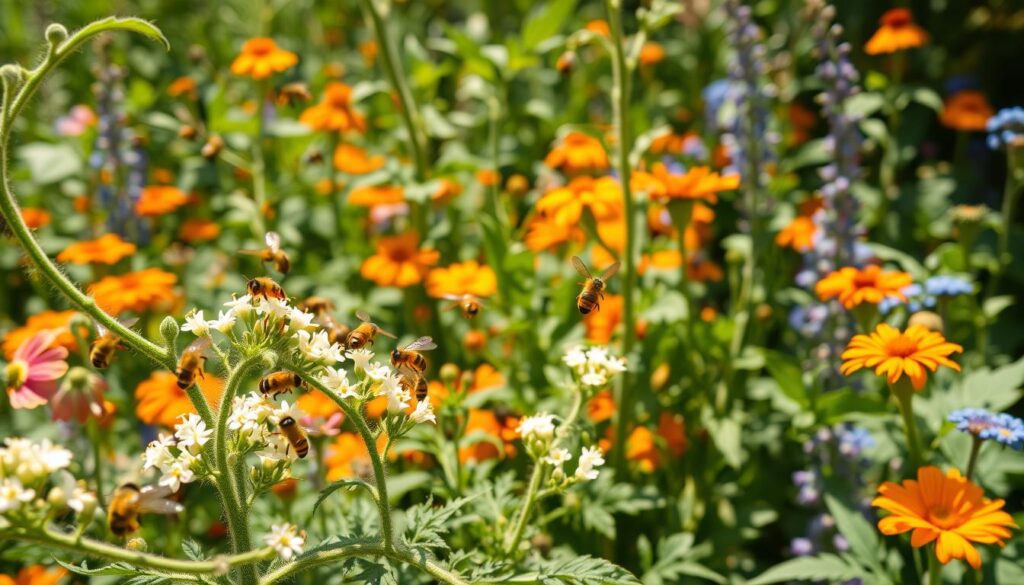
| Flower Type | Pollinator Attracted | Benefits |
|---|---|---|
| Zinnias | Bees, Butterflies | Increases pollination rates and attracts beneficial insects |
| Sunflowers | Bees, Birds | Provides food and shelter for pollinators while being visually appealing |
| Lavender | Bees | Improves fragrance in the garden and attracts numerous pollinators |
Creating a Companion Planting Plan
Designing your companion planting plans can transform your gardening experience. This arrangement not only improves your plants’ growth but also enhances your garden’s overall health. Effective garden space management begins with a solid plan that takes into account the unique needs of each plant. Understanding sunlight, water, and nutrient requirements will help you maximize the benefits of companion planting.
Steps to Develop Your Layout
Start by assessing your available garden space. Consider these steps for an effective layout:
- Measure your garden size and outline the plot.
- Identify areas with full sun, partial shade, and complete shade.
- Research plant compatibility, focusing on plants that benefit each other.
- Create a diagram to visualize plant placement, keeping their growth patterns in mind.
- Implement crop rotation strategies to maintain soil health and prevent pests.
Adjusting Based on Your Space
Your companion planting strategy should adapt to available garden space. If you’re working with limited areas, consider these adjustments:
- Prioritize smaller, faster-growing plants that can thrive alongside larger ones.
- Utilize vertical gardening techniques to maximize upward growth.
- Experiment with interplanting, placing different types of plants close together.
- Regularly monitor plant health and adjust accordingly to ensure optimal growth.
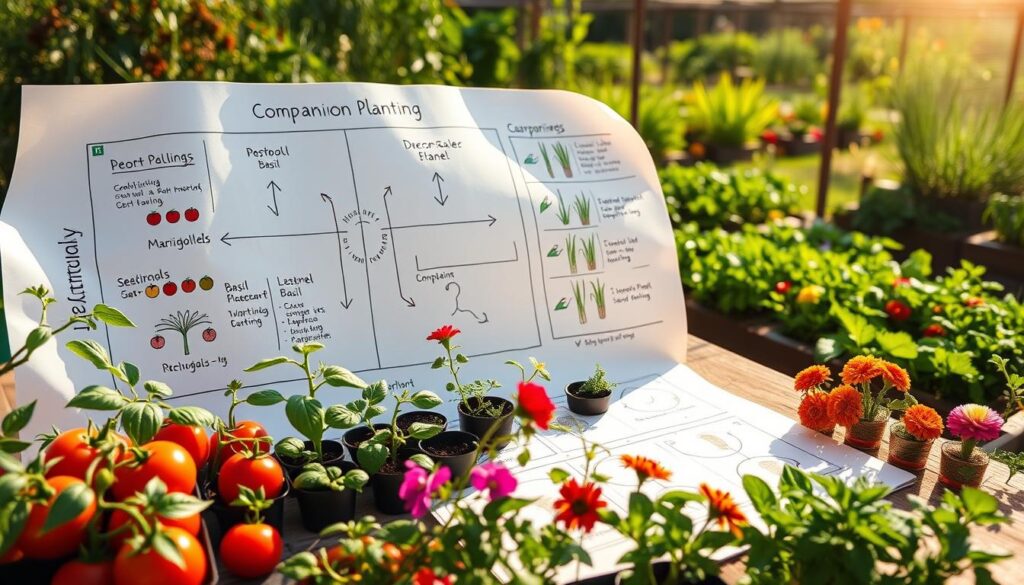
Seasonal Considerations
Understanding seasonal planting strategies for tomatoes plays a crucial role in selecting the best companions for your garden. The timing of your planting can significantly impact growth, pest management, and overall yield. By aligning your tomato planting with the appropriate seasonal companions, you can create a thriving garden.
Warm-Season Companions
As temperatures rise, you should consider planting warm-season companions like basil and peppers. These partners not only thrive in similar conditions but also enhance each other’s growth. Timing is essential; plant these companions after the last frost date in your area to ensure successful development. Both basil’s aromatic leaves and peppers’ spiciness can complement the flavor profile of tomatoes while helping to deter pests.
Cool-Season Planting Strategies
In the early part of the gardening season, implementing cool-season planting strategies for tomatoes offers a different opportunity. Crops such as carrots and cilantro can be interplanted with tomatoes, taking advantage of the cooler temperatures. These combinations can maximize space and improve soil health while making sure that your garden remains productive from spring through fall.
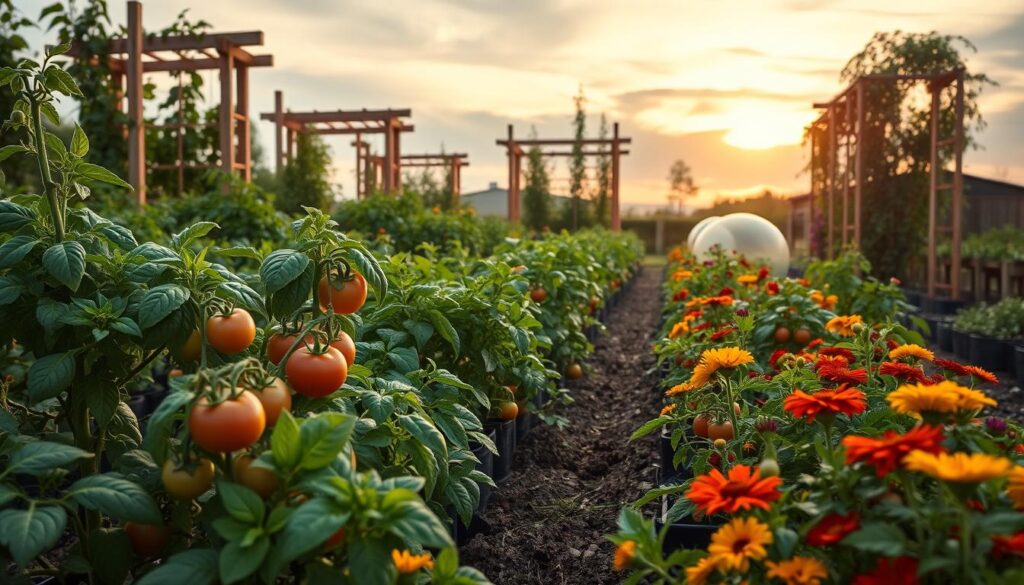
Harvesting and Enjoyment
Timing your harvest is key to achieving the best flavor possible from your tomatoes. The ideal moment for harvesting tomatoes is when the fruits are fully colored and offer a slight firmness to the touch. This ensures that you’re picking them at the peak of their ripeness, providing a burst of rich, sweet flavor that enhances any dish.
Additionally, don’t overlook the culinary uses of companion plants. Herbs like basil and oregano, which thrive alongside your tomatoes, can also be harvested to add fresh, aromatic elements to your meals. Edible flowers such as nasturtiums enhance not only the visual appeal of your dishes but also contribute unique flavors. Incorporating these companion plants into your cooking not only enriches your meals but allows you to explore a variety of recipes that highlight the bounties of your garden.
Being aware of when to harvest these flavorful companions in relation to your tomatoes ensures a delightful culinary experience. The fusion of fresh tomatoes with herbs and flowers from your garden will elevate any dish, making every dining moment a celebration of your hard work and planning. Embrace the process of harvesting tomatoes along with their companion plants, and enjoy creating incredible meals that showcase your homegrown treasures.









